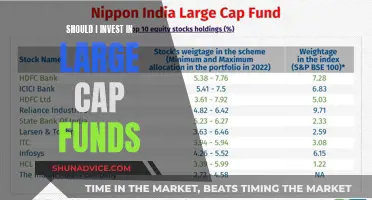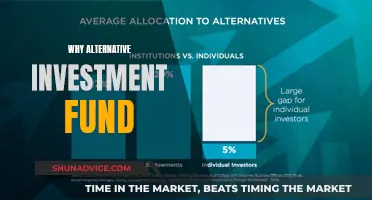
Choosing the right investment fund can be a daunting task, with thousands of options available. The best option for you will depend on your financial goals, risk tolerance, and investment timeframe. There are a variety of investment funds to choose from, each with its own level of risk and potential return. These include managed funds, listed equities, term deposits, cash accounts, and more. It's important to understand the basics of investing, such as the risk/return trade-off, and to consider factors like diversification and fees when making your decision.
What You'll Learn

Growth funds
When considering a growth fund, it is important to assess your risk tolerance and investment goals. Growth funds are high-risk investment instruments and may not be suitable for those close to retirement. They are best suited for investors who are risk-tolerant and willing to invest for at least five to ten years.
HOA Funds: Where to Invest for Maximum Returns
You may want to see also

Defensive funds
Defensive investment strategies are often adopted by portfolio managers for risk-averse clients, such as retirees without steady salaries or those without much capital to lose. The objective is to protect existing capital and keep pace with inflation through modest growth.
A defensive fund will typically include high-quality, short-maturity bonds and blue-chip stocks. A portfolio manager may also hold cash and cash equivalents, such as Treasury bills and commercial paper, to help keep pace with inflation and protect the portfolio in down markets.
Defensive stocks provide consistent dividends and stable earnings regardless of the state of the overall stock market. They are shares in companies with products that are in constant demand, such as water, gas, and electric utilities, or consumer staples like food, beverages, and hygiene products. These companies tend to be more stable during the various phases of the business cycle and are less likely to face bankruptcy due to their relative strength during downturns.
A defensive portfolio won't eliminate day-to-day dips in the market but is designed to help reduce losses in more severe down markets, without sacrificing long-term performance potential.
Hedge Fund GPs: Benefits of Investing in Their Own Fund
You may want to see also

Balanced funds
Compared to actively managed funds, which may evolve in response to changing market conditions or an investor's risk appetite, balanced funds maintain a more consistent asset mix. This means that balanced funds tend to have lower total expense ratios, as the cost of managing the fund is reduced. Additionally, balanced funds allow investors to make periodic withdrawals without disrupting the asset allocation.
However, one disadvantage of balanced funds is that the investor does not have control over the asset allocation, which may not align with their tax-planning strategy. For example, an investor may prefer to keep income-producing securities in a tax-advantaged account, but in a balanced fund, this separation is not possible.
Overall, balanced funds offer a diversified and stable investment option that can provide a healthy mix of growth and income while minimising risk. This makes them a suitable choice for investors seeking a more conservative approach or those with a lower risk tolerance.
Mutual Fund Investments: Reporting 1099-INT Details
You may want to see also

High-yield savings accounts
- SoFi Checking and Savings: Best for High-Yield Online Savings Accounts, 4.50% APY
- CIT Bank Platinum Savings: Best for High-Yield Online Savings Accounts, 4.70% APY
- Capital One 360 Performance Savings: Best for High-Yield Online Savings Accounts, 4.10% APY
- UFB Portfolio Savings: Best for High-Yield Online Savings Accounts, 4.83% APY
- Barclays Tiered Savings Account: 4.50% APY
- LendingClub LevelUp Savings Account: Up to 5.30% APY
- TAB Bank High Yield Savings: 4.52% APY
- EverBank Performance Savings: 5.05% APY
- BrioDirect High Yield Savings Account: 5.15% APY
- Ivy Bank High-Yield Savings Account: 5.00% APY
When choosing a high-yield savings account, it is important to look for accounts with high interest rates and low service charges. It is also beneficial to find an account that meets your overall banking needs, such as providing both checking and savings accounts. Additionally, some accounts offer features such as mobile apps, budgeting tools, and savings buckets that can enhance your banking experience.
It is worth noting that high-yield savings accounts typically have variable rates, which means the yield can change at the bank's discretion. Therefore, if you are looking for a guaranteed yield, you may want to consider a certificate of deposit (CD).
Money Market Funds: Investment Options and Strategies
You may want to see also

Government bonds
There are two main types of government bonds: Treasury bonds and municipal bonds. Treasury bonds are issued by the US government and are considered risk-free. They are backed by the full faith and credit of the US government. Treasury bonds can be purchased directly from the US government at auction through the TreasuryDirect website, or from a broker. Some brokerages also offer ETFs and money market accounts that invest in Treasury bonds.
Municipal bonds are issued by state and local governments or agencies. They can provide tax-exempt interest income to qualified investors. Municipal bonds can be purchased through a broker or via a managed fund or ETF.
Mutual Fund Investment: Current Smart Choices
You may want to see also
Frequently asked questions
A well-diversified pre-mix option is a good place for beginners to start. This is a simple and effective strategy that doesn't require getting caught up in the best-performing investment options, as these tend to fluctuate year-to-year.
The best investment fund option will depend on your goals, risk appetite, and time horizon. Consider your comfort with risk and the return you require to meet your retirement objectives.
Good investment fund options include diversified pre-mix options, managed funds, term deposits, cash accounts, and ASX-listed shares.
Growth options aim to increase your balance faster by investing in a mix of higher-risk investments, such as shares and property. Defensive options, on the other hand, allocate more funds to lower-risk investments, resulting in lower average growth.
Your super fund invests your money for you, and most funds offer a range of investment options, from conservative to growth. You can choose the right investment mix based on your risk tolerance and time horizon.







